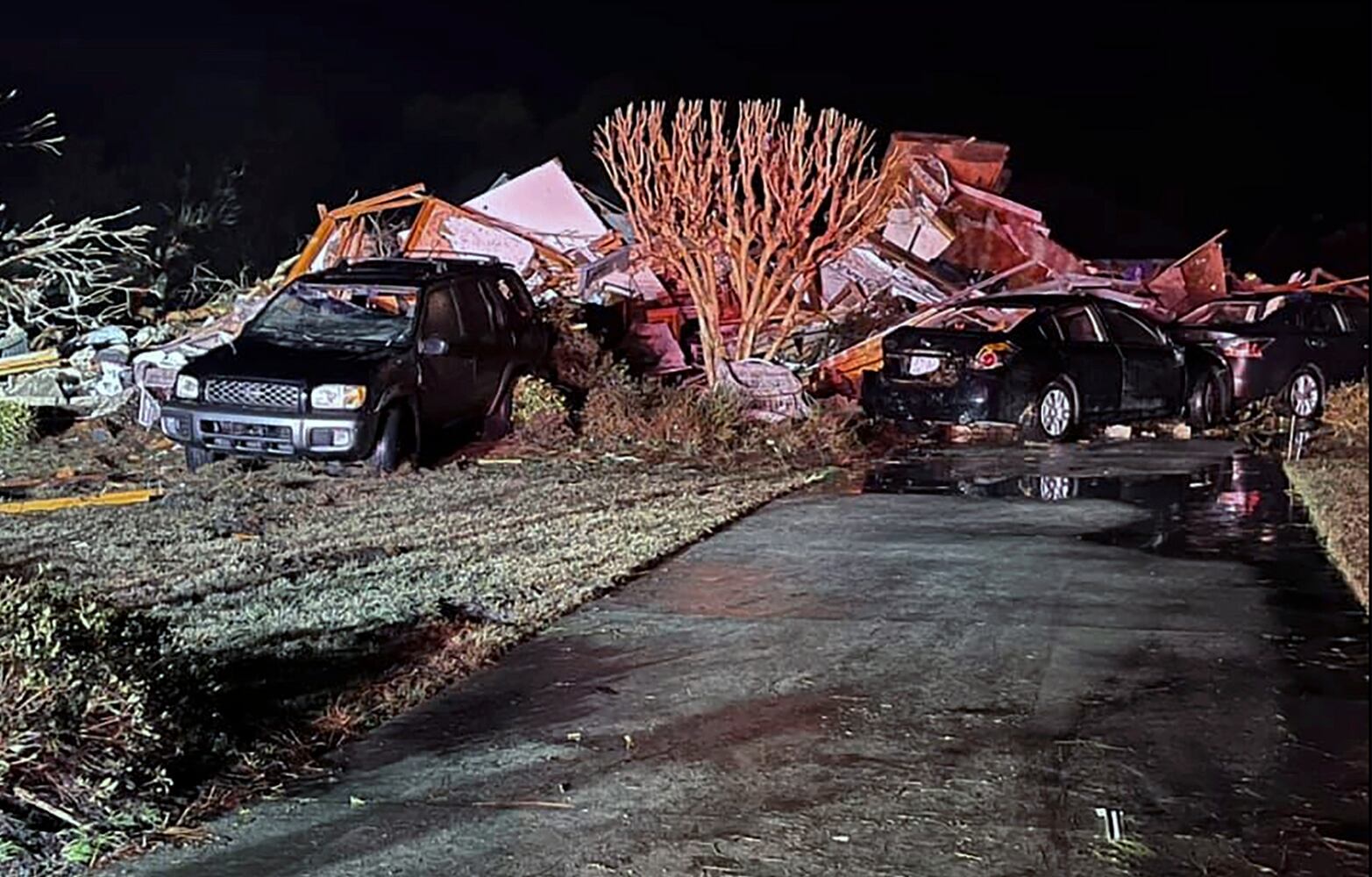A winter storm that left millions without power in record-breaking cold weather claimed more lives Tuesday, including three people found dead after a tornado hit a seaside town in North Carolina and four family members who perished in a Houston-area house fire while using a fireplace to stay warm.
The deadly tornado hit Brunswick County in southeastern North Carolina. A storm survey team from the National Weather Service assessed some of the damage on Tuesday and gave the North Carolina twister a preliminary rating of an EF3 with winds estimated at 160 mph.
“Devastating damage to many homes, especially in the Ocean Ridge Plantation area,” the Brunswick County Sheriff’s Office (BCSO) said on Facebook. “BCSO, Brunswick County Emergency Services and multiple fire and law enforcement agencies remain on scene assessing damages and working to clear debris from roads.”
The storm that overwhelmed power grids and immobilized the southern Plains carried heavy snow and freezing rain into New England and the Deep South and left behind painfully low temperatures. Wind-chill warnings extended from Canada into Mexico.
The storm system also resulted in a sharp reduction in U.S. oil production.
Deliveries from Federal Express, according to Reuters, were being delayed in some cities, though the media outlet did not report which specific metro areas were being affected.
At least 11 deaths were reported from other causes, including car crashes and carbon monoxide poisoning. President Joe Biden’s administration said the weather was likely to cause delays in shipments and deliveries of the COVID-19 vaccine.
In North Carolina, the tornado struck Brunswick County and damaged at least 50 buildings early Tuesday.
Brunswick County emergency services director Ed Conrow said debris is “everywhere,” and work is underway to increase the search for missing people.
North Carolina Gov. Roy Cooper said rescue operations were continuing Tuesday.
“It’s something like I have never seen before. A lot of destruction. It’s going to be a long recovery process,” Brunswick County Sheriff John Ingram said at a news conference early Tuesday.
The National Weather Service’s office in Wilmington, North Carolina, is sending out a team to survey the damage and confirm that a tornado touched down, said Mark Willis, the office’s meteorologist in charge.
“The main thing that happened here was this area of low pressure moved out of the Gulf and had a warm front with it,” Willis said. “And with that warm front, you got the warm, moist air and the correct wind profiles to produce tornadoes.”
On Monday, an F-2 tornado hit northeast Damascus, Georgia, causing residents to run for cover, according to the National Weather Service. The NWS in Tallahassee, Florida, sent out an alert about 4:45 p.m.
Gas leaks were reported and multiple homes were damaged after the tornado touched down.
In Chicago, a foot and a half of new snow Tuesday morning forced Chicago Public Schools to close in-person classes. The National Weather Service reported that 18 inches of snow had fallen in Evanston by 8 a.m. Tuesday, while Midway International Airport had 17.7 inches and O’Hare International Airport reported 7.5 inches.
Illinois State Police and the state Department of Transportation urged residents to stay at home Tuesday while crews clear roadways.
The worst U.S. outages were in Texas, affecting more than 4 million homes and businesses Tuesday. More than 250,000 people also lost power across parts of Appalachia, and another quarter-million were still without electricity following an ice storm in northwest Oregon, according to poweroutage.us, which tracks utility outage reports. Another 4 million people lost power in Mexico.
The Southwest Power Pool, a group of utilities covering 14 states, imposed rolling two-hour blackouts to ease the extreme demand for heat and electricity. It said the outages were “a last resort to preserve the reliability of the electric system as a whole.”
The outages forced a Texas county to scramble to get more than 8,000 doses of Moderna’s coronavirus vaccine into arms. The Harris County Public Health facility lost power after 1 a.m. Monday and its backup generator also failed, said Rafael Lemaitre, a spokesman for Harris County Judge Lina Hidalgo.
In Oklahoma, more than 130,000 homes and businesses were without power as utilities implemented two-hour blackouts at the direction of Southwest Power Pool.
Authorities in multiple states reported deaths in crashes on icy roads from this weather front, including two people whose vehicle slid off a road and overturned in a waterway in Kentucky on Sunday, state police said.
Deaths in Texas included a woman and a girl died from suspected carbon monoxide poisoning in Houston, at a home without electricity from a car running in an attached garage, police said. Law enforcement also said subfreezing temperatures were likely to blame for the deaths of two men found along Houston-area roadways.
With more frigid days expected, frustration mounted over power outages affecting Texas and surrounding states. The surging demand and the loss of some power stations in the cold forced blackouts typically only seen in 100-degree Fahrenheit summers.
The Federal Emergency Management Agency said Texas officials have requested 60 generators from the agency and the priority for their use will be hospitals and nursing homes. FEMA said in the briefing that 35 shelters with a total of more than 1,000 occupants have been opened in Texas.
In Kansas, where wind chills dropped to as low as minus 30 degrees Fahrenheit in some areas, Gov. Laura Kelly declared a state of disaster.
The Latest
Featured





